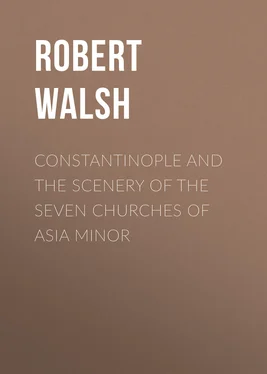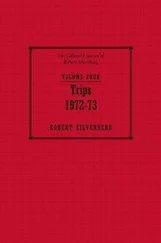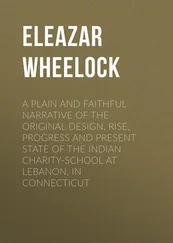Robert Walsh - Constantinople and the Scenery of the Seven Churches of Asia Minor
Здесь есть возможность читать онлайн «Robert Walsh - Constantinople and the Scenery of the Seven Churches of Asia Minor» — ознакомительный отрывок электронной книги совершенно бесплатно, а после прочтения отрывка купить полную версию. В некоторых случаях можно слушать аудио, скачать через торрент в формате fb2 и присутствует краткое содержание. Жанр: foreign_prose, foreign_home, История, foreign_antique, на английском языке. Описание произведения, (предисловие) а так же отзывы посетителей доступны на портале библиотеки ЛибКат.
- Название:Constantinople and the Scenery of the Seven Churches of Asia Minor
- Автор:
- Жанр:
- Год:неизвестен
- ISBN:нет данных
- Рейтинг книги:5 / 5. Голосов: 1
-
Избранное:Добавить в избранное
- Отзывы:
-
Ваша оценка:
- 100
- 1
- 2
- 3
- 4
- 5
Constantinople and the Scenery of the Seven Churches of Asia Minor: краткое содержание, описание и аннотация
Предлагаем к чтению аннотацию, описание, краткое содержание или предисловие (зависит от того, что написал сам автор книги «Constantinople and the Scenery of the Seven Churches of Asia Minor»). Если вы не нашли необходимую информацию о книге — напишите в комментариях, мы постараемся отыскать её.
Constantinople and the Scenery of the Seven Churches of Asia Minor — читать онлайн ознакомительный отрывок
Ниже представлен текст книги, разбитый по страницам. Система сохранения места последней прочитанной страницы, позволяет с удобством читать онлайн бесплатно книгу «Constantinople and the Scenery of the Seven Churches of Asia Minor», без необходимости каждый раз заново искать на чём Вы остановились. Поставьте закладку, и сможете в любой момент перейти на страницу, на которой закончили чтение.
Интервал:
Закладка:
But a new power was now preparing to overrun and astonish the world, not by the sudden and transitory inroad of a barbarous multitude, carrying with it the destruction of an inundation, and, like it, passing on, and remembered only by the ravages it left behind; this was a permanent invasion of a stubborn and persevering race, destined to obliterate the usages of former ancient people, and establish, in their place, its own. On the banks of the Oxus, beyond the waters of the Caspian Sea, there dwelt a nomadic people engaged only in the care of their flocks and herds, and for that reason called Turks, from their rude and rustic habits. They had embraced the Islam , or true faith of Mohammed, and changed the appellation of Turks, which was a term of reproach, to Moslemûna, or “the resigned.” 1 1 The word Islam is mentioned in the Koran as, “the true faith.” It signifies, literally, “resignation.” A professor of it is called Moslem , and, in the plural number, Moslemûna , which is corrupted, by us, into “Mussulman.”
From their remote obscurity in the centre of Asia, they issued, to carry the desolation of Islamism into the Christian world.
The first of this race who penetrated into the Greek possessions in Asia Minor was Othman. He seized upon the passes of Mount Olympus, and instead of razing, he strengthened all the fortified places behind him. His son Orchan conquered all the Christian cities established there, and finally made himself master of Brusa, the capital of Bythinia, which became the seat of the Turkish empire in Asia. The Seven Churches of the Apocalypse shared the same fate. Those lights of the world, swarming with a Christian people, were reduced to small villages, with a few Moslem inhabitants; even Ephesus, the great emporium of Asia, celebrated for its noble temple, had “its candlestick so removed,” that the village of Aysilûk (its modern name) now consists of a few cottages among its ruins, and contains a Christian population of only three individuals. Philadelphia was the only city that made an effectual resistance: though remote from the sea, and abandoned by the feeble Greek emperors, it maintained its Christian independence for eighty years, against the Moslem invaders. From the fame of this first conqueror, his race adopted the patronymic as their civil designation, and called themselves, ever after, Osmanli, or “the children of Othman.”
The first passage of the Turks into Europe was attended with a romantic adventure. Soliman, the son of Orchan, was engaged in a hunting excursion, and was led by the chase to the shores of the Hellespont. An insatiable curiosity induced him to wish to cross to the other side, and visit, for the first time, this new quarter of the globe. But the terror of the Turkish name had so alarmed the Greeks, that strict orders were issued, under the severest penalties, to remove every conveyance by which they could pass from the opposite shore into Europe. Under these circumstances, Soliman formed a raft of inflated ox-bladders, and, availing himself of a moonlight night, he floated over with some of his companions. When they landed, they seized on a passing peasant, who happened to be acquainted with a subterranean entrance into the town of Sestos. He was induced, by threats and bribes, to point it out, and so a few energetic Turks seized by surprise on this first European city. By this exploit a communication was at once established with their companions in Asia. Fresh succours crossed over and seized on Gallipoli, and thus the Turk first planted his foot in Europe.
Amurath availed himself of all the benefits of his brother’s adventurous enterprise. He appointed a singular custom at Gallipoli. The marauding Turks, now established on the European side of the Bosphorus, made slaves of all the Christians they could seize on, and sent them over to Asia by this passage. Amurath claimed for his share a certain portion as toll. Of the young males so obtained, he formed that tremendous militia that were afterwards to terrify and control their own country. He caused them to undergo the rite, and be instructed in the doctrines and discipline, of his own prophet. A Dervish named Hadgee Bectash, of great sanctity and influence, was then called in, to give this corps his benediction. Laying his hand on the head of the foremost, the sleeve of his coat fell over his back, and he blessed them by the name of yeni cheri , or “new soldiers.” Both circumstances afterwards distinguished them−the sleeve of the dervish was adopted as part of their uniform, and the name of janissary, corrupted from yeni cheri, was the terror of Europe for more than five centuries. With these young and vigorous apostates to Islamism, he subdued all the country to the base of the Balkan mountains, and having obtained possession of Roumeli, the “country of the Romans,” as the territory of the modern Greeks was called, he finally established himself at Adrianople, which now became the Turkish capital of Europe.
This prince was succeeded by Bajazet, called, from his impetuosity, and the awful destructiveness of his career, Ilderim , or “the thunderbolt.” He extended his conquests into the heart of Europe, penetrated into the centre of Hungary, and threatened to proceed from thence to Rome, to feed his horses with oats on the altar of St. Peter; but first he resolved to possess himself of the Christian capital of the East. To this end he advanced against Constantinople, and for ten years pressed it with a close siege. Its fate, however, was yet delayed by the sudden appearance of another extraordinary power, which, having subdued the remote parts of the East, and left nothing there unconquered, in the restlessness of ambition turned itself to the west in search of new enemies. This was the power of the Tartars, led on by Demur beg , or “the Iron Prince.” 2 2 He was lame of one leg, and hence called Demur lenk , which we have corrupted into Tamerlane.
To oppose this new enemy, the siege of Constantinople was raised, and its fate suspended while the legions of barbarians encountered one another, and the Thunderbolt was to resist the Man of Iron. The battle was fought on the plain of Angora, where Pompey had defeated Mithridates. After a conflict of two days, the Turks were totally routed. Bajazet fell into the hands of the conqueror, and the treatment he experienced was such as one execrable tyrant might expect, or a still more execrable might inflict. He whose custom it was to celebrate his massacres by pyramids of human heads, erected at the gates of every city he conquered, would not hesitate to treat the rival whom he hated, and had subdued, without pity or remorse. He enclosed his captive in a cage, like a wild beast exposed to public view, and, as he was lame, made him and his cage a footstool to mount his horse. The end of Bajazet corresponded with his life; impatient of control, and stung with desperation, he beat out his brains against the bars of his prison. Tamerlane possessed one redeeming quality, which distinguished him, in some measure, from his fellow-barbarians. He entertained no hostility to Christianity: on the contrary, he allowed a temple, dedicated to its worship, to be erected in Samarcand, his capital. He did not follow up his conquest by renewing the siege of Constantinople; so that this Christian capital, by his interference, was spared for half a century longer.
But the time at length arrived, when the man was born who was permitted by Providence to inflict this destruction. This was Mahomet II., endued with such opposite and contradictory qualities, that he may be esteemed a monster in the human race. He was the second son of Amurath II., by a Christian princess; his father had imbibed so deep an enmity to Christianity, that he brought his son, like Hannibal’s, to the altar, and made him vow eternal hostility to its professors. He succeeded to the throne at the age of twenty-one, and his first acts were to strangle all his brothers, to the number of twenty-two, and to cast into the sea all the wives of his father who might be likely to give birth to posthumous offspring. The progress of his reign was in conformity to this commencement. His fixed and never interrupted intention was, to possess himself of Constantinople, and to convert the great capital of the Christian world into the chief seat of Islamism, and there was no effort of force or fraud which he did not use to accomplish it.
Читать дальшеИнтервал:
Закладка:
Похожие книги на «Constantinople and the Scenery of the Seven Churches of Asia Minor»
Представляем Вашему вниманию похожие книги на «Constantinople and the Scenery of the Seven Churches of Asia Minor» списком для выбора. Мы отобрали схожую по названию и смыслу литературу в надежде предоставить читателям больше вариантов отыскать новые, интересные, ещё непрочитанные произведения.
Обсуждение, отзывы о книге «Constantinople and the Scenery of the Seven Churches of Asia Minor» и просто собственные мнения читателей. Оставьте ваши комментарии, напишите, что Вы думаете о произведении, его смысле или главных героях. Укажите что конкретно понравилось, а что нет, и почему Вы так считаете.












